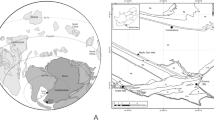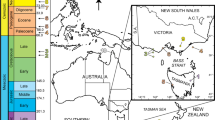Abstract
During palaeobotanical studies in the Antarctic Peninsula in February 1979, late Cretaceous or younger fossil angiosperm leaves were found within volcaniclastic rocks widely believed to be of late Jurassic age1. Although poorly preserved, these fossils are of great stratigraphical importance. They occur at Cape Alexandra, Adelaide Island (Fig. 1), in rocks correlated with the lowest part of the exposed succession (Sloman Glacier succession1). The fossils were found less than 10 km from the type locality for this succession at the head of Sloman Glacier (Fig. 1). However, towards the northern end of the island at Mount Bouvier (Fig. 1), ammonites and bivalves indicate that supposedly equivalent rocks1 are of Upper Jurassic age2. This intensive study of a very small part of the succession indicates that the volcanic history of Adelaide Island is much more complicated than was previously suggested by reconnaissance mapping.
This is a preview of subscription content, access via your institution
Access options
Subscribe to this journal
Receive 51 print issues and online access
$199.00 per year
only $3.90 per issue
Buy this article
- Purchase on Springer Link
- Instant access to full article PDF
Prices may be subject to local taxes which are calculated during checkout
Similar content being viewed by others
References
Dewar, G. J. Scient. Rep. Br. Antarct. Surv. 57 (1970).
Hickey, L. J. Am. J. Bot. 60, 17–33 (1973).
Taylor, B. J., Thomson, M. R. A. & Willey, L. E. Scient. Rep. Br. Antarct. Surv. 82 (1979).
Thomson, M. R. A. & Burn, R. W. Nature 269, 139–41 (1977).
Orlando, H. A. in Antarctic Geology (ed. Adie, R. J.) 629–36 (North-Holland, Amsterdam, 1964).
Grikurov, G. E., Krylov, A. Ya. & Silin Yu. I. Dokl. Akad. Nauk. SSSR, Geol. 172, 168–71 (1967).
Leidelmeyer, P. Leid. geol. Meded. 38, 53 (1966).
Pierce, R. L. Minnesota geol. Surv. Bull. 42, 24–49 (1961).
Barton, C. M. Scient. Rep. Br. Antarct. Surv. 44 (1965).
Davies, R. E. S. Bull. Br. Antarct. Surv. (in the press).
Bell, C. M. Bull. Br. Antarct. Surv. 39, 35–44 (1974).
Adie, R. J. in Antarctic Geology and Geophysics (ed. Adie, R. J.) 137–42 (Universitets-forlaget, Oslo, 1972).
Fleet, M. Scient. Rep. Br. Antarct. Surv. 59 (1968).
Adie, R. J. in Antarctic Research (eds Wexler, H., Rubin, M. J. & Caskey, J. E.) 26–39 (American Geophysical Union, Geophysical Monograph 7, 1962).
Halle, T. G. Wiss. Ergebn. schwed. Sudpolarexped. 3, 14 (1913).
Thomson, M. R. A. 3rd Symp. Antarctic Geology and Geophysics (ed. Craddock, C.) (in the press).
Fraser, A. G. & Grimley, P. H. Scient. Rep. Br. Antarct. Surv. 67 (1972).
Herron, E. M. & Tucholke, B. E. Init. Rep. DSDP Leg 35, 263–78 (1976).
Author information
Authors and Affiliations
Rights and permissions
About this article
Cite this article
Jefferson, T. Angiosperm fossils in supposed Jurassic volcanogenic shales, Antarctica. Nature 285, 157–158 (1980). https://doi.org/10.1038/285157a0
Received:
Accepted:
Issue Date:
DOI: https://doi.org/10.1038/285157a0
Comments
By submitting a comment you agree to abide by our Terms and Community Guidelines. If you find something abusive or that does not comply with our terms or guidelines please flag it as inappropriate.



